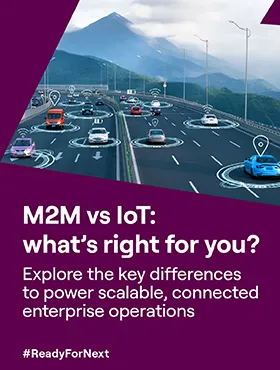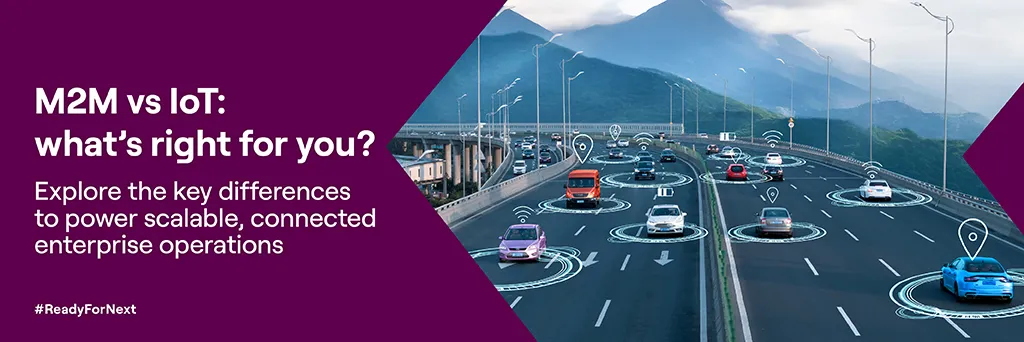frequently searched on Vi
Published on 30th July, 2025
Published by Vi Business
M2M vs IoT: The Right Connectivity for Scalable Enterprise Solutions
Introduction
As digital transformation accelerates across industries, enterprises are adopting intelligent device communication to boost efficiency, reduce downtime, and gain real-time insights. Two technologies that often surface in this context are Machine-to-Machine (M2M) and the Internet of Things (IoT).
While both enable remote device communication, M2M and IoT differ significantly in architecture, scalability, and business outcomes, especially for industrial and commercial-grade deployments like vehicle tracking, EV battery management, point-of-sale terminals, smart metering, connected factories, and surveillance systems.
Understanding the difference between IoT and M2M is critical to leverage them effectively for your business. Read to learn more about IoT vs. M2M, popular IoT and M2M examples and how Vi Business can aid MSMEs to future-proof their businesses.
What is M2M?
M2M (Machine-to-Machine) refers to direct point-to-point communication between devices using wired or wireless channels—often over cellular M2M SIMs or Ethernet. M2M is commonly used to perform specific machine-level functions, such as transmitting a smart meter reading or triggering a device alert based on sensor data.
It’s a closed-loop architecture—ideal for applications that require stable, secure, and relatively low-volume data transmission without extensive cloud or internet dependencies.
Many MSMEs today rely on mobile hotspots to connect to the internet for daily activities, leading to an increasing demand for M2M cellular mobile connections. The Telecom Regulatory Authority of India (TRAI) reported a rise in the number of M2M cellular mobile connections from 69.87 million at the end of April 2025 to 73.91 million at the end of May 2025.
Enterprise Applications of M2M:
● Utility Metering
: Electric, gas, and water meter readings transmitted directly to control centers.● ATM & PoS Terminals
: Secure, standalone connections for real-time transaction data.● Industrial Automation
: Machine health monitoring using Modbus/OPC protocols.● Basic Vehicle Telematics
: Engine diagnostics or GPS-based location tracking.
Why Enterprises Choose M2M:
● Low latency, reliable, and isolated systems.
● Minimal infrastructure dependency.
● Lower cost of ownership for single-purpose use.
● Secure by design (limited internet exposure).
What is IoT?
IoT (Internet of Things) builds on the foundation of M2M—but goes much further. IoT connects devices to cloud platforms via IP-based networks (using NB-IoT, eSIM, LTE-M, LoRaWAN, etc.), enabling real-time analytics, remote control, and cross-device automation at scale.
Unlike M2M’s one-to-one connection model, IoT enables many-to-many interactions, open API integrations, and cloud-based dashboards for remote monitoring and decision-making.
According to a report by McKinsey, IoT is projected to have an estimated economic value of $5.5 trillion to $12.6 trillion globally by 2030. Another industry report by Fortune Business Insights predicts that the global Internet of Things (IoT) market size will grow from USD 714.48 billion in 2024 to USD 4,062.34 billion by 2032, highlighting a compound annual growth rate (CAGR) of 24.3% during the reporting period.
The IoT market in India is also predicted to experience significant growth in the next few years. According to a report by Statista, the revenue in the overall IoT market, which includes various segments like consumer IoT, enterprise IoT, and industrial IoT, along with hardware, connectivity, infrastructure, and platform components, is forecast to shoot up to a staggering ₹2.26 trillion by 2025.
IoT Applications in Business:
● Connected EV Fleets
: Real-time tracking of battery health, charging cycles, geolocation.● Smart Surveillance Systems
: Camera feeds with motion detection and AI alerts via cloud.● Advanced Vehicle Tracking
: Geo-fencing, driver analytics, predictive maintenance.● Smart Agriculture
: Soil sensors, moisture control, and weather forecasting via LoRaWAN.● Smart Manufacturing (Industry 4.0)
: Sensors across assembly lines monitored via edge-cloud platforms.● Retail & Warehousing
: Real-time monitoring of cold chains, inventory movement, and PoS health.
Why Enterprises Choose IoT:
● Scalable to thousands or millions of devices.
● Centralised data management with actionable insights.
● Cloud-based device control and OTA updates.
● Integration with analytics, AI/ML, ERP, and CRM systems.
Key Differences Between M2M and IoT (Enterprise Context)
Here’s a quick table that highlights the key differences between IoT and M2M:
Aspect |
M2M (Machine-to-Machine) |
IoT (Internet of Things) |
Connectivity Type |
Direct device-to-device via cellular (M2M SIM), Ethernet |
Cloud-connected using NB-IoT, LTE-M, eSIM, LoRaWAN, RF Mesh |
Architecture |
Closed-loop, isolated systems |
Open, cloud-integrated networks |
Scalability |
Limited, manual provisioning |
Highly scalable with centralized provisioning |
Data Flow |
One-to-one (device - system) |
Many-to-many (device – platform - apps) |
Cloud Dependency |
Not required |
Integral part of architecture |
Automation Level |
Basic triggers and actions |
AI/ML-driven automation and orchestration |
Security |
More secure due to isolation |
Requires advanced cyber protection measures |
Protocols |
Modbus, OPC, RS-232, TCP |
MQTT, HTTPS, CoAP, LwM2M, APIs |
Software Integration |
Minimal |
Full software ecosystem (cloud, apps, dashboards) |
Use Case Fit |
Simple telemetry & device control |
Real-time analytics, remote ops, integration-heavy systems |
IoT vs M2M: Which One Should Your Enterprise Choose?
There’s no universal answer—it depends on your business goals, scale, and system complexity.
Choose M2M if your solution:
● Requires direct, isolated device communication.
● Has low data volume and doesn’t need cloud access.
● Involves single-purpose machines like smart meters or PoS terminals.
● Doesn’t require frequent updates or scalability.
Choose IoT if your solution:
● Requires real-time insights across distributed assets.
● Needs cloud dashboards, analytics, and API integrations.
● Must manage large device fleets (e.g., EVs, sensors, surveillance units).
● Demands advanced automation and AI-based actions.
Conclusion
Understanding the difference between M2M and IoT is pivotal for strategic technology adoption for your enterprise. There is no one-size-fits-all approach when it comes to device networking. While both these technologies allow automation and device communication, IoT is more scalable with centralised provision. On the other hand, M2M has a relatively constrained scope in today’s dynamic digital landscape. The ultimate choice, however, depends on a thorough evaluation of your enterprise's distinct requirements, including factors such as desired scalability, cloud dependency, and the level of automation required.
The Vi Business Advantage: Enterprise IoT Connectivity That Scales
At Vi Business, we help enterprises across sectors—automotive, utilities, manufacturing, logistics, BFSI, and retail—achieve operational excellence through robust IoT connectivity.
Vi Business offers customised solutions in Enterprise Mobility, Connectivity, Security, IoT & Cloud. Contact us today to explore robust IoT solutions for MSMEs that will enable you to optimise operations, enhance customer experiences and boost your business.
We provide an impressive range of end-to-end IoT solutions that can help with faster deployment and faster ROI. Some of our top products include smart infrastructure solutions, smart mobility solutions, smart utility solutions, integrated IoT solutions, etc.
Partner with Vi Business to Future-Proof Your Enterprise in 2025
From M2M reliability to IoT agility, we deliver tailored connectivity solutions aligned to your goals.
go to top

